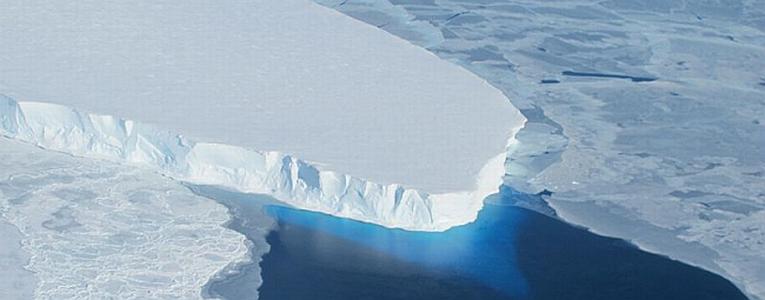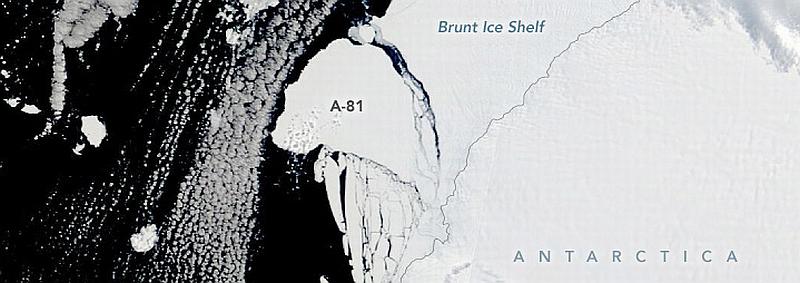
The calving front of Thwaites Ice Shelf in 2012. Photo by JamesYungel | NASA IceBridge.
The continued rapid melting of Antarctica’s Thwaites glacier is worrying, at the very least. The glacier was dubbed “The Doomsday Glacier” by an article in Rolling Stone magazine in 2017. At 80 miles across, Thwaites is the widest glacier in the world—roughly the size of Florida. Every year, it loses 50 billion tons of ice, contributing around 4 percent of annual global sea level rise. If the entire glacier were to melt, it would raise the ocean by 25 inches.
Last September, we saw a blizzard of scary headlines announcing that the doomsday glacier was “holding on by its fingernails,” inspired by a statement by the British Antarctic Survey’s Robert Larter, who said, “Thwaites is really holding on today by its fingernails, and we should expect to see big changes over small time scales in the future — even from one year to the next — once the glacier retreats beyond a shallow ridge in its bed.”
This month, new research by the British Antarctic Survey and the US Antarctic program concluded that Antarctic glaciers may be more sensitive to changes in sea temperature than was thought. The new research suggests that even low amounts of melting can potentially push a glacier further along the path toward eventual disappearance.

 On February 21, 1862,
On February 21, 1862, 
 On February 17, 2010, thirteen years ago today, the
On February 17, 2010, thirteen years ago today, the 

 Happy Valentine’s Day! In honor of both the day and Black History Month, here is an updated repost about
Happy Valentine’s Day! In honor of both the day and Black History Month, here is an updated repost about  In honor of Black History Month, an updated repost about the first African-American pilot in the US Navy,
In honor of Black History Month, an updated repost about the first African-American pilot in the US Navy,  Here is a story well worth retelling; an updated repost in honor of Black History Month; the remarkable story of Robert Smalls.
Here is a story well worth retelling; an updated repost in honor of Black History Month; the remarkable story of Robert Smalls.
 A repost in honor of Black History Month.
A repost in honor of Black History Month.  Since 2020, juvenile orcas within pods that feed on migrating tuna traveling through the Strait of Gibraltar and around the Iberian Peninsula, have taken to bumping and ramming the hulls of small yachts and damaging rudders. In the last several years there have been over 100 orca ‘interactions’ where boats have been spun around and repeatedly rammed.
Since 2020, juvenile orcas within pods that feed on migrating tuna traveling through the Strait of Gibraltar and around the Iberian Peninsula, have taken to bumping and ramming the hulls of small yachts and damaging rudders. In the last several years there have been over 100 orca ‘interactions’ where boats have been spun around and repeatedly rammed.  Born a slave,
Born a slave,  Here is a strange story of a heroic rescue by the US Coast Guard, a stolen boat, and a dead fish left on the front porch of a house in Astoria, Oregon, where the cult classic adventure/comedy movie,
Here is a strange story of a heroic rescue by the US Coast Guard, a stolen boat, and a dead fish left on the front porch of a house in Astoria, Oregon, where the cult classic adventure/comedy movie,  Aircraft carriers can be tough. They cost a fortune to build, so most nations can afford only one or two. They are demanding and costly to operate. They are also extremely expensive to clean up enough to be scrapped.
Aircraft carriers can be tough. They cost a fortune to build, so most nations can afford only one or two. They are demanding and costly to operate. They are also extremely expensive to clean up enough to be scrapped.


 In late February 2022, an
In late February 2022, an